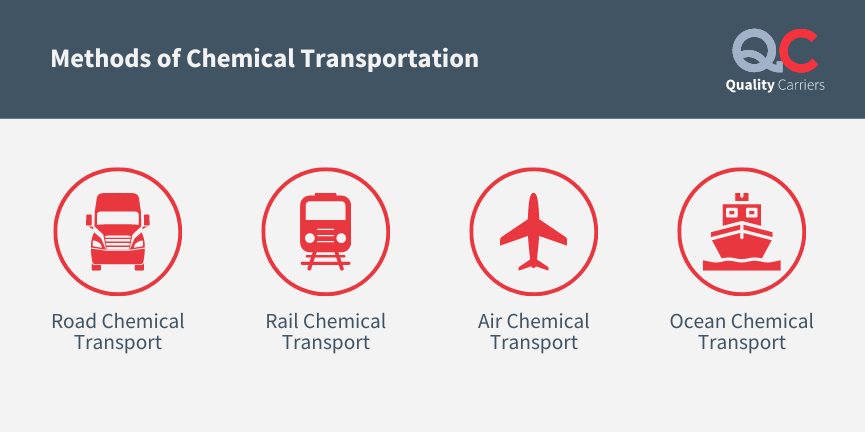Shipping hazardous chemicals is a highly regulated and safety-critical endeavor. Whether you’re an owner operator or part of a larger logistics network, it’s crucial to understand the complexities and precautions associated with transporting hazardous materials.
In this guide, we’ll explore the essential aspects of shipping hazardous chemicals.
Ways in Transportation of Hazardous Chemicals
Transporting hazardous chemicals is a specialized and safety-critical task that involves rigorous protocols and regulations. HAZMAT, short for Hazardous Materials, encompasses a broad spectrum of substances and materials that pose significant risks to individuals, property, and the environment during transportation. These risks include fire, explosions, toxic fumes, and environmental contamination.
The transportation of HAZMAT is governed by a comprehensive set of regulations and guidelines from Hazardous Materials Regulations (HMR) in the United States. These regulations cover the classification, packaging, labeling, and handling of hazardous materials. They also specify safety measures for transport vehicles, emergency response procedures, and training requirements for personnel involved in the transportation process.
On the other hand, Safety Data Sheets, commonly called SDSs, are crucial documents in hazardous chemical transportation. They serve as a comprehensive source of information about the properties, hazards, safe handling procedures, and emergency response measures for a specific hazardous material.
What is a Bill of Lading?

The Bill of Lading (BOL) is evidence of the contract of carriage and a title document. In shipping hazardous chemicals, the BOL is instrumental in detailing the nature of the cargo, its quantity, and its specific classification as a hazardous material. This information is vital for carriers, shippers, chemical transportation companies and emergency responders.
Types of Hazardous Chemicals
Hazardous chemicals come in various forms, each with unique risks and safety considerations. Properly classifying these materials is crucial for safe transportation and handling. Here, we’ll explore the main categories of hazardous chemicals:
CLASS 1: Explosives – Explosive materials are substances that can undergo rapid chemical reactions, releasing significant energy. These materials are classified into different divisions based on their heat, shock, or friction sensitivity. Common examples include dynamite, fireworks, and blasting agents.
CLASS 2: Gases – Hazardous materials encompass many substances stored under pressure or as liquefied gases. They can be highly flammable, toxic, or both. Examples include propane, oxygen, and chlorine.
CLASS 3: Flammable Liquids – Flammable liquids can ignite easily at relatively low temperatures. Gasoline, alcohol, and some solvents fall into this category. Proper storage and handling of these chemicals are critical to prevent fires and explosions.
CLASS 4: Flammable Solids are solid materials that ignite when exposed to a heat source. This category includes substances like matches, magnesium, and certain metal powders.
CLASS 5: Oxidizers and Organic Peroxides – Oxidizers release oxygen, promoting combustion when they come into contact with flammable materials. On the other hand, organic peroxides can be highly reactive and pose fire and explosion hazards. These substances are used in various industrial processes.
CLASS 6: Toxic Materials and Infectious Substances – Toxic materials harm human health when inhaled, ingested, or absorbed through the skin. Infectious substances, on the other hand, can contain pathogens like bacteria or viruses and pose biological hazards. Examples include pesticides, corrosive materials, and medical waste.
CLASS 7: Radioactive Materials – Radioactive materials emit ionizing radiation, damaging living organisms and the environment. These materials are used in various applications, including medical treatments, research, and nuclear power generation.
CLASS 8: Corrosives – Corrosive materials are substances that can cause severe damage to living tissues, metals, or other materials. Strong acids and bases and certain chemicals used in manufacturing processes fall into this category.
CLASS 9:. Miscellaneous Dangerous Goods – This category includes substances that don’t fit neatly into the other classifications but still pose risks during transportation. These can range from asbestos to environmentally hazardous substances.
Methods of Chemical Transportation

Chemical transportation can occur via various modes:
- Road Chemical Transport: This method involves using specialized trucks or vehicles to transport hazardous chemicals. It is commonly used for shorter to medium-distance shipments, offering flexibility and accessibility to various locations. However, road transport has challenges like traffic congestion and accidents, making driver training and vehicle compliance with safety regulations crucial.
- Air Chemical Transport: When rapid long-distance delivery is required, air transportation is the go-to method. Cargo planes are equipped to carry dangerous goods quickly, making them ideal for emergencies and international shipments. Air transport can be costly, and not all hazardous materials are allowed on commercial flights.
- Rail Chemical Transport: Railroads are pivotal in transporting hazardous chemicals, especially over extensive distances. Specialized railcars are designed for various dangerous goods, offering efficiency and reducing highway congestion. However, train accidents involving hazardous materials can have severe consequences, highlighting the importance of stringent safety protocols.
- Ocean Chemical Transport: Ocean transport is the preferred method for international shipments. Chemical tankers are designed to transport liquid chemicals safely across oceans. This approach is cost-effective for long-haul international trade but faces challenges such as adverse weather, piracy in certain regions, and the potential for maritime accidents.
Cost of Chemical Transportation
The cost of shipping hazardous chemicals depends on numerous factors, including the nature of the chemicals, transportation distance, mode of transport, regulatory compliance, and insurance costs. Budgeting for these expenses is vital while ensuring that safety and compliance are never compromised.
Shipping hazardous chemicals demands an unwavering commitment to safety, compliance, and environmental responsibility. Proper classification, documentation, and adherence to regulations are non-negotiable.
FAQs in Transporting Hazardous Chemicals
Yes, some routes, tunnels, bridges, or areas may have restrictions or specific regulations regarding the transportation of hazardous materials. Planning your route carefully and ensuring compliance with local, state, and federal transportation laws is essential.
Hazardous chemical containers must be labeled and marked according to regulatory standards. This includes using specific hazard labels, UN (United Nations) numbers, and proper shipping names. Failing to label and keep correctly can lead to regulatory violations and safety hazards.
Transporting multiple classes of hazardous chemicals together may be allowed under specific conditions, but it must comply with regulatory guidelines. Compatibility, segregation, and proper packaging are critical factors to consider when transporting different classes of hazardous materials together.
Non-compliance penalties vary widely, including fines, license suspension, and legal consequences. More importantly, non-compliance can lead to accidents, injuries, or environmental damage. Staying compliant is essential for safety and legal reasons.




